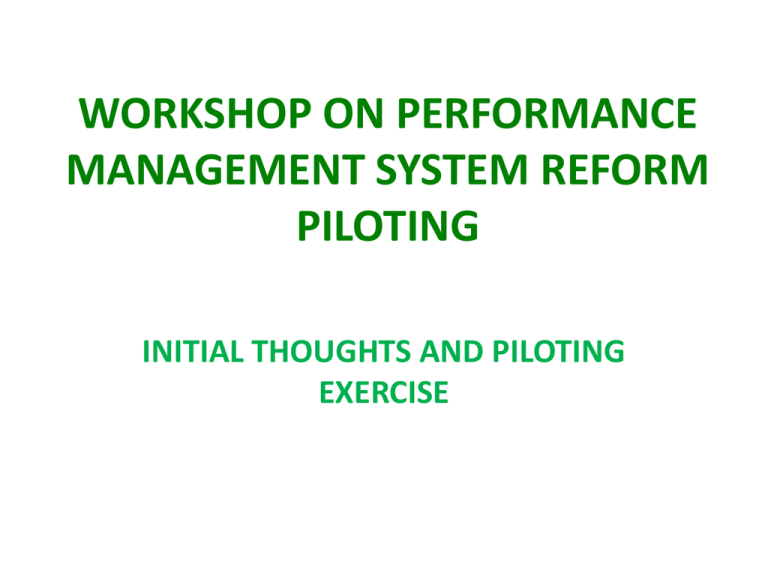revised training presentation pms mohca
advertisement

WORKSHOP ON PERFORMANCE MANAGEMENT SYSTEM REFORM PILOTING INITIAL THOUGHTS AND PILOTING EXERCISE OUTLINE • • • • • • • • • RATIONALE/CONTEXT CHALLENGES CIVIL SERVICE REFORM INITIATIVE AND PMS GPMS AND PMS CYCLE ANNUAL PERFORMANCE AGREEMENT INDIVIDUAL WORK PLAN SAMPLE IMPLEMENTATION TIMELINE EXERCISE RATIONALE/CONTEXT National Level Long Term and Medium Term Perspective Plans Organization level Plans and Performance Agreements Individual level Work Plans CHALLENGES • Weak Results Chains • Individual Work Plan Culture not Followed • Where Prevalent: No Clear Alignment with broader/Higher Results Areas/Objectives • Individual Performance Assessment/Rating Not Based on any Objective Assessment : No or weak linkages to results achieved/not achieved • No System to Differentiate Performers from NonPerformers WHAT IS THE SOLUTION? Building a Result Based PMS?? • Integration/Alignment of Five Year Plans and Annual Budget • Instituting Annual Work Plan into the Budgeting Cycle • GPMS: Annual Performance Agreement drawn from/based on AWP • Civil Service Reform(PMS): Cascading Responsibilities from AGENCY-DEPARTMENTDIVISION-INDIVIDUAL and weave RBM into Performance Management PMS REFORM OBJECTIVES: to differentiate performers from non-performers through: • Alignment • Cascading Accountability to various levels • Assess organizational performance against organization’s Objectives/targets and link employee performance 7 EHANCED PERFORMANCE PERFORMANCE MANAGEMENT SYSTEM REFORM : NEW ELEMENTS • PERFORMANCE RATING • FORCED RANKING: Based on Organisation GPMS Performance FORCED RANKING BASIS: Five Year Plans GPMS: Performance Agreement signed: ( Organisation Results Achievement alignment with Individual Performance Rating) Prime Minister and Ministers Prime Minister and Dzongdags Prime Minister and Heads of autonomous agencies Ministers and Secretaries Secretaries and Department Heads GPMS EVALUATION AND RATING Page No. 9 FORCED RANKING APPROACH % of different Performer category Category Definition Outstanding (%) Very Good (%) Need Improvement (%) Category 1 GPMS Performance >=90% 30 70 0 Category 2 GPMS Performance >=80 20 80 0 0 95 5 0 75 25 Category 3 Category 4 GPMS Performance >=70 GPMS Performance >=60> 10 GPMS Cycle A Beginning of government term 1 2 Identification of national priorities ▪ Identification of NKRAs/SKRAs of the government for the government term Identification of outcomes by Ministry/Agency ▪ Finalisation of five year plans for Ministries /Dzongkhags and Agencies based on SKRAs Annual B 1 Annual work planning and target setting ▪ Identification of objectives and prioritization ▪ Dec-Feb Target Approval & Annual performance agreement signing June-July Recognition and support ▪ Publishing of scores ▪ Awards ▪ Oct-Dec 5 Evaluation of performance ▪ Annual performance evaluation ▪ July –Sept-next fiscal year 4 11 2 Mid-Year Review Dec-Jan 3 PMS Cycle 1 Individual work planning ▪ March-April Individual work plan Approval & submission to HRD July-August Promotion and Awards ▪ Dec-Jan 5 Performance Evaluation ▪ Oct-Dec 4 12 2 Mid-Year Review of individual work plans Jan-Feb 3 GPMS and PMS Cycle Alignment A 1 Annual work planning and target setting ▪ Identification of objectives and prioritization ▪ Dec-Feb Individual Work Plan: March April Individual work plan Approval & submission to HRD July-August Promotion and Award: Dec-Jan Recognition and support ▪ Publishing of scores ▪ Awards ▪ Oct-Dec 5 13 Target Approval & Annual 2 performance agreement signing June-July Performance Evaluation: Oct-Dec Evaluation of performance ▪ Annual performance evaluation ▪ July –Sept-next fiscal 4 year Mid Year Review of Individual Work Plan: Jan-Feb Mid year Review: Dec-Jan Format of Annual Performance Agreement Section 1 Ministry’s Vision, Mission, Objectives. Section 2 Key objectives , priorities, success indicators and targets. Section 3 Trend values of the success indicators. Section 4 Description, definition and measurement success indicators. Section 5 Specific performance requirements from other Ministries/Dzongkhags/Agencies that are critical for delivering agreed results. Section 2: Key objectives, priorities, success indicators and targets. Col. 1 Col. 2 Col. 3 Col. 4 Col. 5 Col. 6 Target / Criteria Value Objective To enhance food security Weight 30% Actions Weight Rice Production MT 15 Increase Maize production Maize production MT 9 IncreaseMi lk production Milk production MT 6 Action 2 55% Action 3 Action 1 To promote culture Unit Increase Rice production Action 1 To improve health status Success Indicator Action 2 15% Action 3 Excellent 2000 Very Good 1900 Good 1800 Fair 1700 Poor <1700 Section 3: Trend Value of Success Indicators Objective To enhance food security Success Indicator Unit Actual Value for FY 12/13 Increase Rice Rice Productio production n MT 1900 1950 2000 2200 Actions Increase Maize production Increase milk production To improve health status Action 1 Action 2 Action 3 To promote culture Action 1 Action 2 Action 3 Actual Value for FY 13/14 Target Value for FY 14/15 Projected Value for FY 15/16 Projected Value for FY 16/17 2400 Projected Value for FY 17/18 2700 Section 4: Description ,definition and measurement of success indicators 1. Provide definition for indicators which are not easy to understand 2. Provide milestones for indicators which cannot be achieved in the fiscal year Section 5: Specific performance requirements from other departments that are critical for delivering agreed results Organization Type Organization Name Ministry DoA,MoAF Relevant Success Indicator Rice Production What Is Your Requirement From This organization Machineries Justification For The requirement Quantify your requirement From this organization What Happens If your requirement is not met Performance Management Cycle BEGINNING OF YEAR MID-YEAR REVIEW END OF YEAR IMPLEMENTATION OF ACTIVITIES Step 1 Prioritization of Objectives and Activities and formulating Workplan based on APA/GPMS Step 3 Performance Evaluation (Composite Score) Step 2 Signing and sealing of Work Plan with Supervisors and submitting to RCSC Page No.20 Year End Performance Evaluation Methodology (GPMS) Col. 1 Col. 2 Col. 3 Col. 4 Col. 5 Col. 6 Target / Criteria Values Objective Weight Action Success Indicators 30% Increase Rice ,Maize and Milk Producti on Weigh t Excellen t Very Good Good Fair Poor 100%-91% 90%81% 80%71% 70%61% 60%50% Achiev e ment Raw Score Weight ed Raw Score Rice production % .50 30 25 20 10 5 15 75% 37.5% % Increase in number of people with 2 access to a primary health center within 20 KMs % .30 20 18 16 14 12 18 90% 27% Number of hospitals with ISO 9000 3 certification by December 31, 2009 % .20 500 450 400 300 250 600 100% 20% Composite Score = 84.5 % 1 To Enhance Food Security Uni t Year End Performance Evaluation Methodology Col. 1 Col. 2 Col. 3 Col. 4 Col. 5 Col. 6 Target / Criteria Values Objective To enhance food security Weight 30% Action Increase rice, maize and milk producti on Success Indicators Uni t Weigh t Excellen t Very Good Good Fair Poor 100%-91% 90%81% 80%71% 70%61% 60%50% Achiev e ment Raw Score Weight ed Raw Score 1 Rice production % .50 2000 1900 1800 1700 1700 1750 75% 37.5% 2 Maize production % .30 3000 2800 2500 2400 <200 0 2800 90% 27% 3 Milk production % .20 500 450 400 300 250 600 100% 20% Composite Score = 84.5 % Year End Performance Evaluation Methodology Col. 1 Col. 2 Col. 3 Col. 4 Col. 5 Col. 6 Target / Criteria Values Objective To enhance food security Weight 30% Action Imcrease rice,maiz e and milk producti on Success Indicators Uni t Weigh t Excellen t Very Good Good Fair Poor 100%-91% 90%81% 80%71% 70%61% 60%50% Achiev e ment Raw Score Weight ed Raw Score 1 Rice Production % .50 2000 1900 1800 1700 1700 1750 75% 37.5% 2 Maize production % .30 3000 2800 2700 2600 2600 2800 90% 27% 3 Milk production % .20 500 450 400 300 250 600 100% 20% Composite Score = 84.5 % NATIONAL PLANNING FRAMEWORK AND PMS National Level National Key Result Areas 16 NKRAs under four pillars Sector Key Result Areas 120 SKRAs with over 300 KPIS and Interventions Sector/Sub-Sector FIVE YEAR PLAN FOR ORGANISATION INCLUDING LGS Objectives from PA can be shared/relevant to more than one Deptt/Division Outcomes for Plan Programme=Organisational Objectives Identify Department/Division Outputs against relevant Organization Objectives in the PA Identify Objectives relevant to Division/individual from the above and formulate Action Plan Performance Agreement/AWP Against each Output define Activities and Success Indicators Individual Work Plan to be discussed and agreed between Supervisor and Employee Guiding Principles for Individual Workplan and Alignment of individual Performance to Agency Performance Government Machinery’s core purpose: Nation Building including providing citizen services Delivery through Key Institutions: Executive ( Government) and Bureaucracy ( Civil Service) The Ministry has signed performance agreement with HPM Ministry level Performance targets needs to be cascaded down to Department level performance targets Department level Performance targets need to be broken down into division level Performance targets The Division level Performance Agreements have to be translated into individual work plans 25 PLAN OBJECTIVE NKRAS SKRAS Oganisational Objectives (APA) Department Objectives Division Outputs Individual Outputs 26 Breaking Organization objective into division level outputs and indicators 27 Breaking Organization objective into division level outputs and indicators 28 Breaking division level outputs into Individual Activities 29 Implementation timelines Activity Timeline Responsibility Training of Ministry Taskforce 1st Week of February 2015 RCSC PMS Team Training of Ministry Staff on Individual Work Plan preparation 2nd Week of February Ministry Taskforce Preparation of Individual 2nd Week Feb-14th March work Plans for FY 2014-15 2015 based on signed PA Ministry Submission of individual work plans of Ministry to RCSC Ministry Taskforce 15 March 2015 THANK YOU! 31





